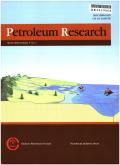Enhancing oil recovery with MWCNT and GO nanocomposites in high salinity heterogeneous media
IF 4
Q1 Earth and Planetary Sciences
引用次数: 0
Abstract
Water injection remains the predominant method in the oil recovery process, but chemical flooding methods such as nanohybrid injection, with its distinct advantages, emerge as a promising alternative to traditional water flooding (WF). This study employed a straightforward synthesizing method, specifically the sol-gel process, to graft polyacrylamide (PAM) onto Graphene Oxide (GO) and Carbon Nanotube (CNT). The objective was to combine the advantages of both polymer and nanoparticle flooding. Our investigation comprised a comprehensive series of static and displacement tests, aiming to investigate the impact of nanohybrid injection in comparison to conventional water and polymer flooding. A series of static tests, SEM, TEM, FTIR, as well as viscosity, IFT, contact angle, and stability assessments, were conducted. As dynamic tests, a series of injection tests were done using a glass micromodel with a high degree of heterogeneity containing both connected and disconnected fractures which makes injection fluid's work very hard to recover oil. Results of static tests such as bottle and TGA, showed that the synthesized nanohybrids have great stability against harsh conditions of the reservoir in case of formation water salinity and temperature conditions which differentiates our work from previous studies. By analyzing the results of dynamic tests it was found that reduction of Interfacial Tension or IFT (which is the forces acting at the interface of nanofluids and oil) showed the most effect on oil recovery as CNT/PAM nanohybrid were able to lower the IFT value the most compared to the other injection fluids and therefore exhibited the highest oil recovery factor Alongside IFT reduction mechanism, mobility control was found to be another important factor specially in case of recovering heavy oil when GO/PAM outperformed CNT/PAM's recovery factor as GO/PAM has more viscosity than CNT/PAM.
MWCNT和氧化石墨烯纳米复合材料在高盐度非均质介质中提高采收率
注水仍然是采油过程中的主要方法,但化学驱方法,如纳米混合注入,以其独特的优势,成为传统水驱(WF)的一种有希望的替代方法。本研究采用一种直接的合成方法,特别是溶胶-凝胶法,将聚丙烯酰胺(PAM)接枝到氧化石墨烯(GO)和碳纳米管(CNT)上。目的是结合聚合物和纳米颗粒驱油的优点。我们的研究包括一系列全面的静态和驱替测试,旨在研究纳米杂化注入与常规水驱和聚合物驱的影响。进行了一系列静态测试,SEM, TEM, FTIR,以及粘度,IFT,接触角和稳定性评估。在动态测试中,采用玻璃微模型进行了一系列注入测试,该模型具有高度非均质性,包含连通和不连通裂缝,这使得注入液很难采油。瓶子测试和TGA等静态测试结果表明,合成的纳米杂交体在地层水盐度和温度条件下具有很强的稳定性,这与以往的研究结果有所不同。通过对动态测试结果的分析,发现界面张力或IFT(作用在纳米流体和油界面上的力)的降低对采收率的影响最大,因为与其他注入流体相比,CNT/PAM纳米混合材料能够最大程度地降低IFT值,因此具有最高的采收率。由于GO/PAM比CNT/PAM具有更大的粘度,因此在回收稠油时,流动性控制是另一个重要因素,特别是当GO/PAM的回收率优于CNT/PAM时。
本文章由计算机程序翻译,如有差异,请以英文原文为准。
求助全文
约1分钟内获得全文
求助全文
来源期刊

Petroleum Research
Earth and Planetary Sciences-Geology
CiteScore
7.10
自引率
0.00%
发文量
90
审稿时长
35 weeks
 求助内容:
求助内容: 应助结果提醒方式:
应助结果提醒方式:


